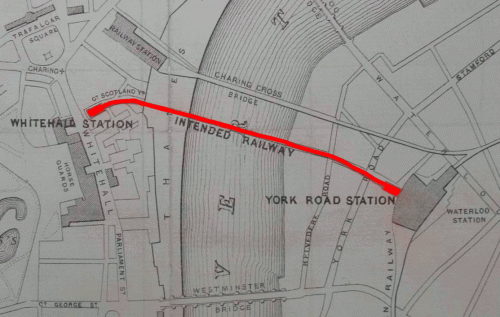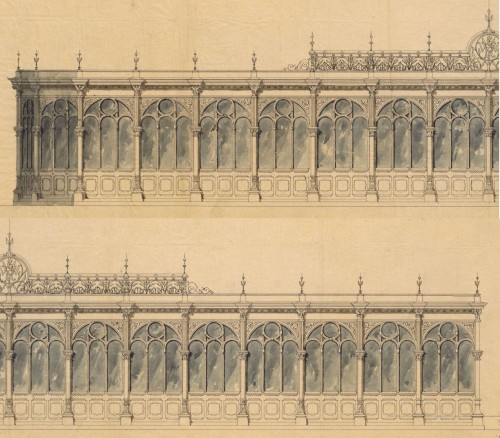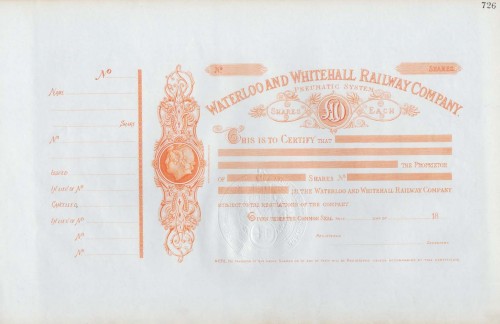Part two of a five part series.
Download all five parts as a Kindle eBook from Amazon today or read part one here.
Birth of the Waterloo to Whitehall Railway
Yesterday, I described how there were experiments in the pneumatic railway which proved the invention would work, and on the 15th May 1865 a prospectus was published in the national press for the construction of a commercial railway between Waterloo and Whitehall.
It’s worth looking at that in depth, as it explains a lot about how the railway was to work and the economic justification for it.
First though, we have to consider the need for such a railway.
The first Waterloo Station, which was much smaller than the current station had been built in 1848 but passengers needing to get across the river either had to pay a toll of a halfpenny to use the Hungerford pedestrian bridge (leading to today’s Charing Cross), or walk down to Westminster Bridge. So, a short railway carrying passengers from Waterloo to Whitehall seemed like a sure success.
 Railway route map – from the prospectus submission
Railway route map – from the prospectus submission
The problem is that it had to pass under the Thames, and the only other tunnel to do that had been the Thames Tunnel at Rotherhithe, which took 18 years to build and cost a fortune due to is vast size. It was after all designed for horse and cart. The pneumatic railway had the huge advantage of being much smaller, just a tube very slightly larger than the carriage itself.
The prospectus, thus finally published sought to raise £135,000 from investors in shares of £10 each.
A key point to note, on a technical basis was that the old system necessitated a pressure of from 120 to 160 oz per square inch to move the train whereas their new system would need just a pressure of three or four ounces per square inch – largely because it would run down a slope towards the river, so gravity would provide some of the initial acceleration.
As they wrote, “in its present form the pneumatic system is simply an adaptation of the process of sailing to railway; the wind being produced by steam power and confined within the limits of a tube.”
To quote the prospectus, its peculiar advantages over the conventional steam locomotive were:-
First. The pneumatic tube being smaller than the ordinary railway tunnel, the lines will occasion less interference with property and displacement of dwellings, and be constructed more expeditiously and at far less cost; while being noiseless and free from vibration in operation, they may be introduced where a locomotive line would not be tolerated.
Secondly. The dead weight of the locomotive being got rid of, the service will be more prompt, and therefore better suited for the working of a short local traffic, while however frequent the dispatches, there is no danger of collision, since two trains can never meet within the tube.
Thirdly. Steep inclines and sharp curves are readily and safely worked on the pneumatic system. The line at Sydenham was purposely constructed with an incline of 1 in 15 (somewhat steeper than the worst part of Holborn-Hill), and with curves of eight chains radius, it was traversed with ease and regularity.
Fourthly. From the absence of smoke, steam, and other objectionable accompaniments of the locomotive, and the complete ventilation of the tunnel by the continuous draught of air through it, the working is attended with perfect comfort to the passengers.
Lastly. The working expenses and the cost of maintenance are less the power being stationary; and the wear and tear of rolling stock reduced to a minimum.
Having outlined the benefits of the railway, they describe the route, which would start at an underground station in Great Scotland Yard, and be continued in brickwork under the Thames Embankment to the river, across which it will be carried in a watertight iron tube encased in cement concrete, laid and fixed in a channel dredged out of the bed of the river. From the river the line was to be continued in brickwork under College Street and Vine Street to a station convenient for the traffic of the York Road and the Waterloo Terminus of the South-Western Railway.
The prospectus boldly stated that the cost of the “undertaking has been calculated with unusual care”, although as we will later see, this was to prove an idle boast.
Once construction was completed though, the prospectus predicted that the trains would be able to depart at intervals of from three to four minutes from each end – a frequency of dispatch that was unheard of before.
To gain that level of train dispatch, although only one tube was used, each station would have two platforms. As a carriage was disgorging passengers, the carriage on the other platform would be slid into position for the return trip. They expected to be able to run the service with just three carriages alternating between each other.
Financially, they made the assumption that — on average — there will be for each train at least five first-class passengers at 2 pence each, and 20 second-class passengers at 1 penny each. Upon that assumption, the total receipts per train, multiplied by the number of trains per day, at 15 each way every hour from 7am to 12pm, gave a total gross annual revenue of £23,268, which was considered sufficient to generate a return of 10 percent for the investors.
The prospectus concluded by noting that the railway could be constructed in just one year once Parliamentary approval had been granted.
You may recall the Samuda Brothers mentioned yesterday – well, their ship building yards on the Isle of Dogs were given the contract to construct the four huge cast iron tubes to be laid in the Thames, which seems amusing considering their earlier work with the rival Atmospheric Railway system.
The pumping station at Waterloo was described as containing a 22 feet wide spinning wheel contained within an iron case. Spinning at different speeds to drive air into the tunnel to blow the carriage over to Whitehall, and then it would be used to suck the carriage back. The system would use the recently invented electric telegraph to signal which option to use at the engine. It was claimed that the air pressure could reach 14lbs per square inch on the carriage to propel it down the tunnel. Iron doors at each end of the tunnels would help to contain the air pressure from blowing into the stations themselves[5].
Another firm, Messrs. Brassey and Co were awarded the contract for the river bed works, which were to be extensive. There is no record of who were to build the brick tunnels on either side of the river, nor the stations.
A rare copy of an architects drawing of the Whitehall Station can be found in the UK’s National Archives, and shows a fairly large surface building, with a lower level for the train platforms. What is interesting to note, is that at the time, people didn’t understand how short railway services would be used, so the new station still included a Ladies Waiting Room and toilets.
Similar designs were still adopted on parts of the early London Underground elsewhere, until it was eventually realised that no one used them on what was a “turn up and go” service.
 Side Elevation of the Whitehall Station
Side Elevation of the Whitehall Station
The railway itself was formed from three sections – the tubes within the river, then two cut and cover brick tunnels on either side of the river. The construction method within the river itself required that a channel was dug along the river bed in which four cast-iron tubes would be laid. To support them, you need foundations. The plan would be to construct three concrete piers in the river by driving down iron caissons into the riverbed about 270 feet apart and digging down by hand. Lined probably with brick it seems, the piers were built up until around 20 feet under the level of the river bed, then the rest of the Thames riverbed was dredged to the required depth. The tubes themselves were to have an internal diameter of 12 feet and external diameter of 15′ 3″ and each section was 250 feet (some references say 240 feet) long. The wall of the tubes was constructed from three-fourths inch boiler plate, surrounded by four rings of brickwork[6].
The weight of each tube was put at around 1,000 tons.
Although largely forgotten today, the news of the railway did generate some commentary in the national press at the time.
I quite liked how in July 1865, the Morning Herald correspondent wrote that there is every reason to believe that he would be taking tickets at Whitehall and walking coolly into a carriage and surrendering himself to the fate of a projectile, and will travel as a pellet does though a popgun.
Certainly the novelty of the propulsion lead to some flights of literary fancy with descriptions such as a line containing a tempest closed up within an iron case being one of my personal favourites[7].
The bill itself was passed on the 5th July 1865, and construction itself started a few months later, on Wednesday 25th October[8] (or Thursday in some reports[9]).
 An original share certificate – from my personal collection
An original share certificate – from my personal collection
Initially, they used steam powered machines to dredge the river on the south side by College Wharf, and the land at Scotland Yard was swiftly enclosed with wooden walls in preparation for clearing the site[10].
Next – the construction starts running into difficulties.
The web research notes will be published in part five.
Download all five parts as a Kindle eBook from Amazon today







The act of parliament that gave powers for the construction of the Waterloo to Whitehall railway is in the process of being repealed: http://www.london-se1.co.uk/news/view/6407
Yeup – that is mentioned in a later part of the series.
I]m sure you’ve seen it, but there is a well-known engraving that is a cross-section of the London Embankment. At the bottom of the engraving, going all the way across is a tube, that most people might think is a sewer but is, I believe, the pneumatic tube pipe.